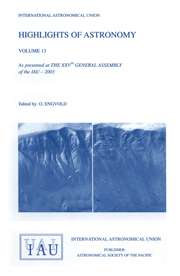No CrossRef data available.
Article contents
p-mode frequency corrections due to convection
Published online by Cambridge University Press: 30 March 2016
Extract
Convection consists of rising hot and descending cool parcels of gas. In order to assess the effect of such an in homogeneity on acoustic waves a simple model has been proposed by Zhugzhda and Stix (1994). The model consists of a sequence of alternating vertical layers with temperatures T 1 and T 2 and upward and downward velocities V 1 and V 2. At the interfaces between the layers the horizontal component of the velocity and the pressure are continuous. This model allows to determine the phase velocity of a vertically propagating acoustic wave. The main result is that, with increasing frequency, this phase velocity approaches the sound speed of the cooler layers. The reason of such a behavior is that the horizontal structure of the wave is oscillatory in the cool layers, but exponential (evanescent) in the hot layers, so that there is a certain amount of wave trapping in the cool layers. An analogous effect of trapping in a horizontal layer has been described by Kahn (1961) for the temperature minimum of the solar atmosphere.
Information
- Type
- II. Joint Discussions
- Information
- Copyright
- Copyright © Kluwer 1995

